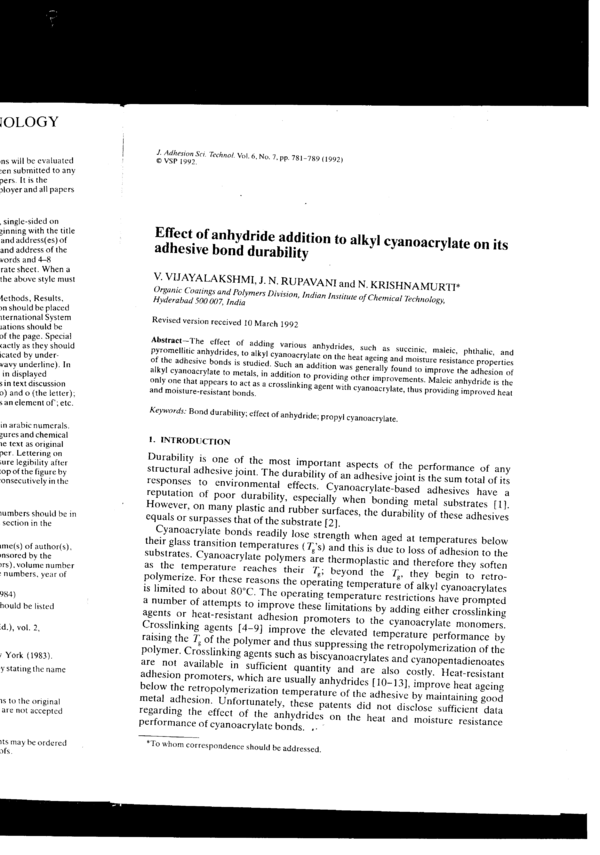Effect of Anhydride Addition to Alkyl Cyanoacrylate on its Adhesive Bond Durability
Effect of Anhydride Addition to Alkyl Cyanoacrylate on its Adhesive Bond Durability
Folder:
Year:
Abstract:
The effect of adding various anhydrides, such as succinic, maleic, phthalic, and pyromellitic anhydrides, to alkyl cyanoacrylate on the heat ageing and moisture resistance properties of the adhesive bonds is studied. Such an addition was generally found to improve the adhesion of alkyl cyanoacrylate to metals, in addition to providing other improvements. Maleic anhydride is the only one that appears to act as a crosslinking agent with cyanoacrylate, thus providing improved heat and moisture-resistant bonds.
DOI:
10.1163/156856192X00430
Type of document:
Language:
IOLOGY
VHS will be evaluated
zen submitted to any
pers. It is the
ployer and all papers
,single~sided on
ginning with the title
and address(es) of
and address of the
words and 4-8
rate sheet. When a
the above style must
lethods, Results,
)n should be placed
iternational System
iations should be
of the page. Special
tactly as they should
icated by under
avavy underline). In
in displayed
5 in text discussion
0) and o (the letter);
5 an element of’; etc.
in arabic numerals.
gures and chemical
ie text as original
per. Lettering on
iure legibility after
top ofthe figure by
ronsecutively in the
iumbers should be in
section in the
ime(s) of author(s),
unsored by the
)rs), volume number
:numbers, year of
984)
hould be listed
id.), vol. 2,
1 York (1983).
y statingthe name
18 to the original
are not accepted
its may be ordered
ofs.
J. Adhesion Sci.
Technol. Vol.6, No. 7,pp. 781-789 (1992)
© VSP 1992.
Effect of anhydride addition to alk
_ yl cyanoacrylate on its
adhesive bond durability
Organic Coatings and Poly
Hyderabad 500 007, India
Revised version received 10 March 1992
Keywords: Bond durability; effect of anhydride; propyl cyanoacrylate.
1. INTRODUCTION
responses to environmental effects. Cyanoacrylate—based adhesives have a
reputation of poor durability, especially when bonding metal substrates [1].
However, on many plastic and rubber surfaces, the durability of these adhesives
equals or surpasses that of the substrate [2].
erating temperature restrictions have prompted
e these limitations by adding either crosslinking
__________
*To whom correspondence should be addressed.
782 I/. Vi/ayalakshmi et al.
Therefore, we report here quantitative data on the heat ageing and moisture
resistance properties of the adhesive bonds formed using cyanoacrylates
containing different anhydrides, between various metals and other substrates.
2. EXPERIMENTAL
All the raw materials used in this investigation were at least 98% pure.
2.]. Synthesis of n—pr0pyl cyanoacrylate (PIC/1)
n—Propyl cyanoacetate was synthesized by reacting n—propyl alcohol (1.0 mol)
with cyanoacetic acid (1.2 mol) in the presence of p—toluene sulphonic acid and
benzene in an amount equal to the total weight of the reactants.‘The contents
were heated to reflux and the course of the reaction was followed by the amount
of water removed azeotropically and collected in a Dean-Stark trap. The
reaction took 6-8 h for completion and during this period, 1 mol of water was
collected in the Dean-Stark trap. The reaction product was washed to remove
catalyst and unreacted ‘cyanoacetic acid, and then dried over anhydrous sodium
sulphate. Benzene was stripped off and the product was distilled under reduced
pressure (b.p. 106—108°C at 10 mmHg, yield 70-75%). Purity 98% as
determined by gas liquid chromatography (GLC); 11%” 1.4040; dfi" 1.0117.
n—Propyl cyanoacrylate was then prepared by condensation of the n—propy1
cyanoacetate with paraformaldehyde in the presence of piperidine and potassium
hydroxide (0.1% each, based on reactants) dual catalysts and using benzene in an
amount equal to the reactants for azeotropic removal of water. The mole ratio of
cyanoacetate to paraformaldehyde was maintained at 1.30. The reaction
product, an oligomer, was then treated with polyphosphoric acid to neutralize
the catalyst and decanted to remove the solid phosphates. The oligomer was then
subjected to depolymerization at 150—240°C at 0.1-2.0 mmHg pressure. The
crude monomer thus obtained was again redistilled for purification at 60-62°C
(1-2 mmHg) and stabilized with 80-100 ppm sulphur dioxide and 100-150 ppm
hydroquinone (yield 88%; purity 99.5% as determined by GLC; Hf)” 1.4314; dfi“
1.0050. It was also characterized by ‘H—NMR (80 MHz Varian FT—80A NMR),
‘3C—NMR (Bruker AM 300 MHZ), and mass spectrometry (70 eV Micromass
VG 7070, UK) methods. The ‘H- and “C-NMR spectra are illustrated in Figs 1
and 2, respectively. The mass spectral diagnostic fragments are shown below:
CN 0 43
J 1 J 1
52 80 110
Coments go here:
- Log in to post comments

